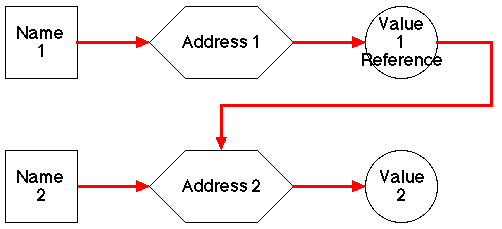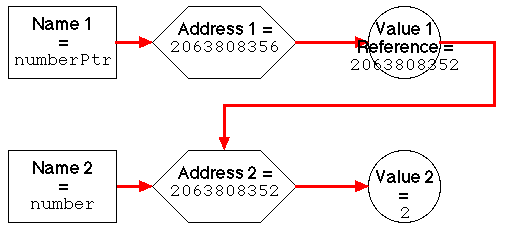The type of a data item defines:
The process of associating a type with a data item is referred to as a data declaration.
2. Scalar and Compound types. Scalar types define data items that can be expressed as single values (e.g. numbers and characters). Compound types (also referred to as composite or complex types) define data items that comprise several individual values. scalar types are generally pre-defined, while compound types are often programmer-defined.
3. Discrete and Non-discrete types. Discrete types (also refered to as linear or ordinal tpes) are types for which each value (except its minimum and maximum) has a predecessor and a successor value. The opposite are referred to as non-discrete types.
4. Basic and Higher Level types. Basic types (also refered to as a simple types or type primitives) are the standard scalar predefined types that one would expect to find ready for imediate use in any imperative programming language. Higher level types are then made up from such basic types or other existing higher level types. Higher level types are not necessarily programmer defined - for example many imperative languages include a string high-level type.
Every imperative languages supports a number of standard basic data types:
| Data item | Ada | C | Pascal | Modula-2 |
|---|---|---|---|---|
| Character (integers in the range n..m | character | char | char | CHAR |
| Integer (range n..m) | integer | int | integer | INTEGER |
| Natural number (range 0..m) | CARDINAL | |||
| Real or floating point number | float | float | real | REAL |
| Logical type | boolean | boolean | BOOLEAN | |
| Charcater string | string | text | ||
| Void | void |
Note that the type void supported by C indicates a type whose value corresponds to "nothing".
|
Ada:
|
C:
|
Note that Ada supports multiple initialisation (e.g. NUM_C, NUM_D: integer:= 3;) while C does not.
Adjectives are used to specify classes of numeric types. Some C examples are given below:
| Adjectives and Type | Size in Bits | Values |
|---|---|---|
| unsigned short int | 16 | 0 to 65535 |
| signed short int, short int, short | 16 | -32768 to 32767 |
| unsigned long int | 32 | 0 to 4294967296 |
| signed long int, long int, long, int | 32 | -214748368 to 2147483647 |
| float | 32 | Real number to approx 6 sig. figs. |
| double | 64 | Real number to approx 15 sig. figs. |
| long double | 128 | Real number to approx 33 sig. figs. |
The most high level approach to defining range/precision is through explicit specification. Example imperative languages where this is supported include Ada and Pascal. In Ada this is achieved using a general type declaration statement as follows:
type SCORE is range 0 .. 100; type TEMPERATURE is digits 4; type PERCENTAGE is digits 4 range 0.0 .. 100.0;
Ada example program using explicit range and precision specification:
with TEXT_IO; use TEXT_IO;
procedure PERCENTAGE is
type PERCENTAGE is digits 4
range 0.0 .. 100.0;
package PERCENTAGE_INOUT is new float_io(PERCENTAGE);
use PERCENTAGE_INOUT;
SCORE1, SCORE2: PERCENTAGE;
begin
get(SCORE1);get(SCORE2);
put(SCORE1);put(SCORE2);
new_line;
end PERCENTAGE;
|
Many imperative languages (Ada, Pascal) allow the programmer to access constants that give information about the default properties of a given type. In Ada such constants are referred to as attributes. Some common (Ada) attributes include:
| Type | Attributes |
|---|---|
| integer | first, last |
| float | digits, small, large |
| character | pos, val |
Example usage:
with CS_IO; use CS_IO;
procedure ATTRIBUTES is
begin
-- Lowest integer
put("first = ");
put(integer'first); new_line;
-- Highest integer
put("last = ");
put(integer'last); new_line;
-- Number of digits for floating point number (precission)
put("digits = ");
put(float'digits); new_line;
-- Lowest floating point number
put("small = ");
put(float'small); new_line;
-- Highest floating point number
put("large = ");
put(float'large); new_line;
-- Code for letter A
put("pos(A) = ");
put(character'pos('A')); new_line;
-- Letter associated with code 66
put("val(66) = ");
put(character'val(66)); new_line;
end ATTRIBUTES;
|
Note that the attributes first and last specify the default Ada integer range, whilst the attributes small and large specify the default Ada floating point range. The attribute digits then specifies the default precision for Ada floating point numbers. Output from the above will be as follows:
first = -2147483648 last = 2147483647 digits = 15 small = 1.94469227433161E-62 large = 2.57110087081438E+61 pos(A) = 65 val(66) = B |
Pointers are variables that have as their value an address, i.e. a reference to another data object (Fifure 1). The consequence of this is that we have a second "access" route to Value 2 in Figure 1; the standard route through Name 2 and a second rout by dereferencing the Valu 1 accessed through Name 2.

|
Figure 1: C POINTER>
* (Asterisk) & (Ampersand)
int *numberPtr;
*numberPtr = *numberPtr + 1;
numberPtr = &xIn this case x is referred to as a reference variable.
Consider the following C example:
#include |
This will output the following:
n = 2 address of n = 2063808352 nptr = 2063808352 address of nptr = 2063808356 value pointed at = 2 n = 4 address of n = 2063808352 nptr = 2063808352 address of nptr = 2063808356 value pointed at = 4 |
Note that the address of number and the value of numberPtr are the same. We can illustrate this as shown in Figure 2.

|
Figure 2: C POINTER EXAMPLE>
There are many situations where it is desirable for programmers to define their own types:
Not all languages support the concept of programmer defined types (Ada and Pascal do, C does not --- C allows renaming of type definitions which is not wuite the same thing). Where supported orogrammer-defined types are presented using a type declaration statement. This binds a "new" type definition with a type name (remember that a data item declaration statement binds a data item name to a type definition). In Ada and Pascal type declaration statements have the general form:
type <TYPE_NAME> is <TYPE DEFINITION> ; <TYPE_NAME> = <TYPE DEFINITION> ;
Note that in Pascal type declarations must be grouped together in a type declaration section which must be preceded by a const declaration section (if any), and followed by a var declaration section (again if any).
Ada example type declarations incorporating specific ranges and/or precisions:
type SCORE is range 0 .. 100 ; type TEMPERATURE is digit 3 ; type PERCENTAGE is digits 4 range 0.0 .. 100.0
Note that in each case the Ada compiler will deduce that the types SCORE and TEMPERATURE are integewr types and that the type PERCENTAGE is a floating point type. Once the above types have been declared they can be utilised in the usual manner:
A_VALUE : SCORE ; SUMMER : TEMPERATURE := 20 ; X_VALUE, Y_VALUE : PERCENTAGE := 100.0;
If in the above declarations, an attempt is made to assign a value outside the specified range an error will result.
It is sometimes desirable, given a particular application, to use more descritive (application dependent) type names for particular types. Again this offers advantages of:
In Ada this is achieved using a type declaration statement (see above):
subtype REAL_T is float; NUMBER: REAL_T;
In C a type definition construct is used. This has the general form:
typedef <DEFINITION> < NAME OR NAMES>
Example:
typedef float REAL, *REALPTR; REAL x; REALPTR xPtr;
In both of the above examples an alternative name for the type "float" has been declared. In addition, in the C example, a pointer to the new type has also been declared. Note that by convention, in C, alternative names are typed in uppercase.
Languages such as Ada and Pascal do not specifically support the concept of pointers as used in C, however itb is possible to define a variable that has as its value an address (reference). Such data items are known as access ir reference variables (the concept also exists in Java).To declare an access value the reserved word access is used in the declaration. Example:
with CS_IO; use CS_IO;
procedure ACCESS is
type INTEGERPTR is access
integer;
INT_PTR: INTEGERPTR:=
new integer'(2);
begin
put(INT_PTR.ALL); new_line;
end ACCESS;
|
Given a particular application it is sometimes also useful to characterise a sub-set of values of some other pre-existing type. This is supported by languages such as Ada (but not C) where a subtype declaration statement is used as follows:
subtype DAY_NUMBER_T is integer
range 1..31;
DAY: DAY_NUMBER_T:= 10;
Here the type DAY_NUMBER_T is declared as a "sub-type" of the type integer (the new types range is a sub-set of that available for the supper-type). A similar effect can be achieved in Pascal (although the languages does not specifically support a "subtype" statement).
Some imperative languages that support the concept of sub-types also provide some predefined ("built-in") sub-types. For example Ada supports two predefined sub-types. For example Ada supports two predefined sub-types of the type INTEGER which are defined as follows:
subtype NATURAL is INTEGER range 0..INTEGER'LAST; subtype POSITIVE is INTEGER range 1..INTEGER'LAST;
(note the use of the integer attribute last). Use of subtypes offers similar advantages to those associated with the use of programmer defined types:
Both offer similar advantages when many computations. However, generally speaking, where a data item is required to display many of the features of the standard INTEGER or FLOAT types a subtype declaration should be used. Type declarations are usually used to describe what are termed compound types (e.g. arrays), but more on this later.
Macro substitution is where some string replaces every occurrence of an identifier in a program. This is supported by C (but not Ada or Pascal). To define a macro substitution we include a statement at the beginning of our C program of the form:
#define < macro name> < macro string>
For example:
#define TRUE 1
will replace the identifier true, where ever it occurs within the program, with the string 1 during compilation.
Return to imperative home page or continue.
Created and maintained by Frans Coenen. Last updated 03 July 2001